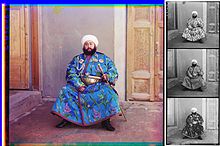Sergei Mikhailovich Prokudin-Gorsky

Sergey Prokudin-Gorsky ( Russian Сергей Михайлович Прокудин-Горский , scientific. Transliteration Sergei Michajlovič Prokudin-Gorsky ; born August 18 . Jul / thirtieth August 1863 greg. In Funikowa Gora , Vladimir province , Russian Empire ; † 27. September 1944 in Paris ) was a Russian pioneer of color photography .
Live and act
Prokudin-Gorski studied chemistry with well-known chemistry professors such as Mendeleev in Saint Petersburg , Berlin and Paris . His own research resulted in patents for the production of color slides and for the projection of moving color images. Around 1905 he began the project to systematically document the entire Russian Empire in color photographs with the help of his inventions . The color photographs were intended to be used, among other things, for the upbringing of children in order to teach them about the history, present and future of the Russian Empire.

Prokudin-Gorski's photographs are a very important historical testimony to the Russian Empire shortly before the outbreak of the First World War . His motifs range from medieval churches and monasteries of ancient Russia to railway lines and factories of the then modern Russian industry. One of his very first pictures shows the writer Leo Tolstoy .
Equipped by Tsar Nicholas II with a darkroom installed in a wagon and given two permits for entering restricted areas, Prokudin-Gorski began his photographic work in 1909, which he completed in 1915. He used an interchangeable slide camera that Adolf Miethe had developed. After the October Revolution in 1918 he fled via Norway and England to France , where he settled in Paris and died there in 1944. The complete collection of his photographs were acquired by the Library of Congress in 1948 and made available to the public.
Photographic process
admission

In the process he developed, three monochrome photo plates are taken in quick succession, each with different color filters ( red , green and blue ).
reproduction
By projecting all three plates with the help of the light corresponding to the color filter , a colored image of the photographed original was created. This means: three light sources with the appropriate filter project their image from the respective photo plate (according to the slide principle using additive color mixing ) onto a canvas. At that time, however, the resulting images could not be developed on photo paper .
literature
- Sergei Michailowitsch Prokudin-Gorski, Robert H. Allshouse (Eds.): Photographs for the Tsar: The Pioneering Color Photography of Sergei Mikhailovich Prokudin-Gorskii Commissioned by Tsar Nicholas II. Doubleday, 1980, ISBN 0-385-27158-1 . (German edition: The Russian Empire under Tsar Nicholas II in historical color photographs. Berlin 2013)
- Sergei Mikhailovich Prokudin-Gorskii: Nostalgia, The Russia of Tsar Nicholas II in color photographs by Sergei Mikhailovich Prokudin-Gorskii . Verlag Die Gestalten, Berlin 2013, ISBN 978-3-89955-459-5 .
Web links
- Illustrated biography of SM Prokudin-Gorski (2011)
- The world from 1900 to 1917 in color (Russian / English)
- The complete works of Prokudin-Gorski on the website of the Library of Congress (English) - direct link to the pictures
- The Empire That Was Russia The Prokudin-Gorskii Photographic Record Recreated (English)
- Reproduction of photographs by Sergei Prokudin-Gorski (1863–1944) (Russian)
Individual evidence
- ↑ Early Color Photography: Colorful for Life. In: Spiegel online. April 6, 2011.
| personal data | |
|---|---|
| SURNAME | Prokudin-Gorski, Sergei Michailowitsch |
| ALTERNATIVE NAMES | Прокудин-Горский, Сергей Михайлович (Russian) |
| BRIEF DESCRIPTION | Russian pioneer of color photography |
| DATE OF BIRTH | August 30, 1863 |
| PLACE OF BIRTH | Funikowa Gora , Vladimir Governorate , Russian Empire |
| DATE OF DEATH | September 27, 1944 |
| Place of death | Paris , France |
